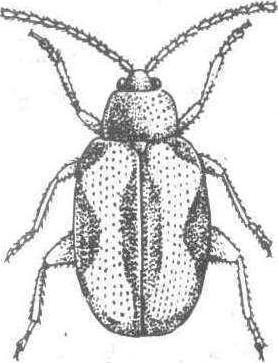黄曲条跳甲striped flea beetle
Phyllotreta striolata Fabricius,昆虫纲,鞘翅目,叶甲科。世界性广布种,寄主以十字花科蔬菜为主。成虫体长约2 mm,黑色有光泽,翅鞘中央有黄色曲条。两端大,中央狭,其外侧中部凹曲颇深,内侧中部直形,仅前后两端向内弯曲。后足腿节膨大(见图),适于跳跃。末龄幼虫体长约4 mm,长圆筒形,黄白色。中国一年发生4~8代,春秋多发,以成虫在残株落叶下、杂草土隙中越冬,华南终年繁殖。成虫善跳,高湿时尚能飞,趋光。成虫食叶成小孔,幼虫蛀根成许多弯曲的虫道或咬断须根,还能传播软腐病。可采用清洁田园、深耕晒土、移栽无虫苗和化学防治围歼喷药等方法进行防治。

黄曲条跳甲